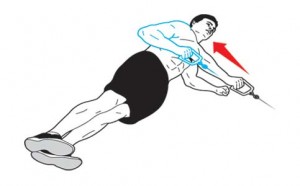Now that I've got you checking out everybody's pancake butt, it's time to learn how to fix this disturbing trend. For best results, follow this 3-step plan.
The Side Plank Done Right
Consider the locomotion and movement patterns we use most often: Sitting, Rising from a chair (half squat), Walking, Running straight ahead. Then think about some of the common knee issues people face: IT Band Syndrome, Patellofemoral syndrome, (Exercise-induced knee pain in general). What's the link?
Bad Posture = Bad Running?
Spreading the Truth About Running and Fat Loss - Part 2
Be An Athlete First and a Runner Second
Lift Like A Distance Runner
In endurance sports we tend to get carried away with improving our engine, our aerobic capacity. But isn't it also how much force you can direct into the ground? When you run, you are fighting gravity. That is where the majority of our energy goes. The better equipped you are to fight gravity, the better you will run.
What Are You Doing In The Gym?
As a Fitness Professional, one of the post popular services I offer is program design. My clients realize that they may be an expert in their field, but not when it comes to objectively designing their own results-based fitness program. Makes sense, right? I've studied formally and continue to learn directly from leaders in my industry so that I can stay current. One of the thoughts that naturally runs through my mind as I look around a gym is, “Why are they doing that exercise?”
It's not that I am in disagreement with their choice.
Rather, I'd love to know the context of the choice. Are they doing knee extensions to improve knee extension performance? Gain muscle in that area? How does that exercise, get them closer to their goals?
Chances are, they aren't performing a set of lat pulldowns to win the Lat-Pulldown World Championships, right?
So why have you chosen the exercises that you're currently doing?
What's your goal? Why are you at the gym? See, only once you have clearly defined your goal can you choose appropriate exercises, rest intervals, etc.
You should always question exactly how certain exercises relate to your goals. Are they helping? How do you know?
My point today is to get you to think critically about what you're doing in the gym. In my experience far too many people are doing all sorts of exercises because they think it will help them perform better, they promise to “work” a certain muscle or, worse, because someone else was doing it and it looked cool.
I want you to question your exercises. Do they actually lead to an increase in performance? Or do they just make you better at "exercising"? Is your goal to workout? Or is your goal to become a faster runner? Let your goals dictate your training program.
Here a few of my favorite examples of PROVEN exercises that improve your performance:
- Heavy deadlifts are proven to increase force output ...and make you faster.
- Performing a chop and lift pattern improves your core timing … and improves your stability.
- Depth Jumps improve leg stiffness and power delivery ...and make you faster.
- Diaphragmatic breathing restores proper core function ...and improves your mobility/stability.
- Push-Press improves power transfer from lower to upper body ...improves efficiency.
- Jumping rope improves coordination, posture and elasticity ...all great things for runners.
If a client comes to me and has a lot of training experience, one of the first things I do is find out if there are any exercises I can eliminate from their current program.
- What is redundant?
- What doesn't match their goal?
- What is counter-productive?
Whenever I learn a better move, I don't just add the exercise. I also take something away. When I first adopted this practice, I threw away several moves that I thought were effective, but really weren't. I was left with 2 exercises! (The deadlift and push-up, an effective, if minimalist, routine!)
I encourage you to do the same. Are there any movements you practice in the gym that aren't helping you reach your goals? If you're not sure, please contact me or a local fitness professional to help you streamline your program. Have a great day!
Core Confusion
At the conclusion of the weekly Lululemon Run Club run I lead everyone through a brief series of simple core exercises. I'm pretty sure most of you know that training your core is important, but I just want you to know WHY you're doing it and WHAT the "core" actually is. Let's focus on what the core actually is. I recently read a great post on visualizing the core and the author likened the core to a balloon. You can read the post here. The take home point is that just like a balloon, your core is more complex than a 6-pack, low back, and obliques. You aren't a series of parts. What you do to one part of your core will affect what happens to another part.
Press into a balloon and the rest of the balloon expands. Hollow out the front of your abdomen and the lower back starts to bulge outward and/or your diaphragm can't function properly...
 So, since you aren't a series of parts, it's time to start training that way. This means choosing exercises that train your core in the same way that you rely on your core during movement. And since we run, I'd like to pose a question:
So, since you aren't a series of parts, it's time to start training that way. This means choosing exercises that train your core in the same way that you rely on your core during movement. And since we run, I'd like to pose a question:
When, during the running movement pattern, do we round our spine and 'crunch'? I mean, besides running to the sink to hurl or something, you shouldn't be running while looking like a hunchback!
So no more crunches, K?
Now we use exercises that challenge us to PREVENT spinal movement.
In other words, we want to choose appropriate plank exercises that challenge us to maintain a neutral spine position -despite gravity trying its best to pull us out of that position. Don't be tempted to try a more intense version of an exercise unless you OWN the beginner version. Can you keep your head/shoulders/tailbone in alignment? Or are you sagging at the low back? Has your head begun to sink?
A strong core means you can transfer power from your arms to your legs efficiently. Jog in place. Now pump your arms really fast. What happens? Yep, your legs move faster. They have no choice because you are not a series of parts. Everything is connected and if your core is strong then you'll use less energy to run the same pace. Cool, huh?
And hopefully in the final 100m of your next race, you'll be the one who is maintaining form all the way to the finish, pumping those arms furiously and transferring all of that power to your legs.
You won't be injured due to form breakdown and you'll pass that annoying guy that was threatening to take your glory for the last 1/2 mile.
Although, I gotta give it to the girl in the video. Never Give Up!


